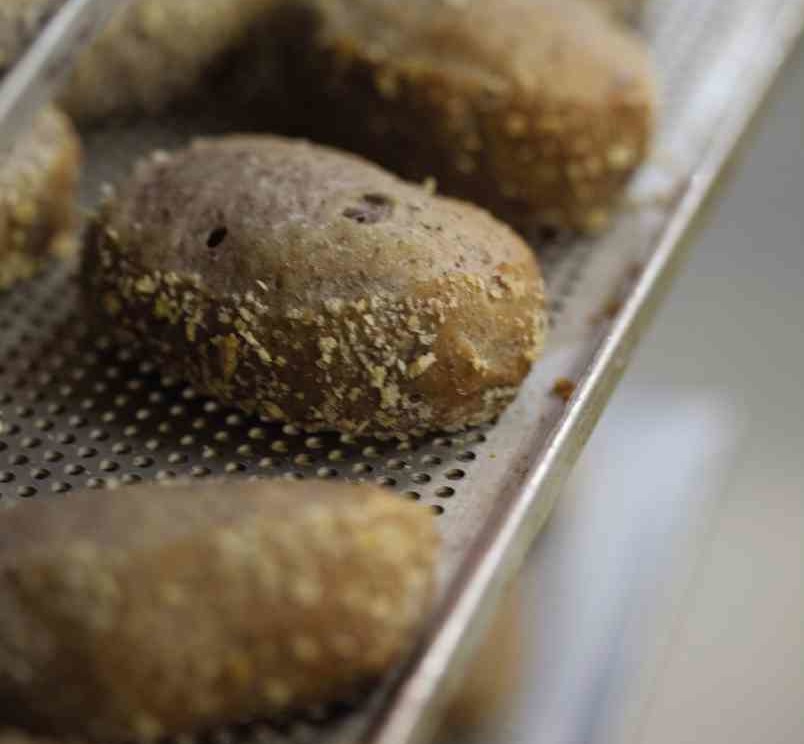The success of Madrid Fusión Manila (MFM) 2016 saw a number of remarkable and innovative dishes from foreign and local chefs.
The exchange of knowledge on creativity and cuisine in the food congress created yet another major impact on world gastronomy. People were fascinated to witness popular and hard-to-find ingredients in diverse and imaginative epicurean reinventions. Amy Besa and Romy Dorotan of Purple Yam Philippines and New York, Myke “Tatung” Sarthou, and Michael Aspiras of Scout’s Honor and Le Petit Soufflé gave especially impressive performances in showcasing Philippine flavors and ingredients.
They shared with Inquirer Lifestyle their brilliant culinary creations for MFM 2016.
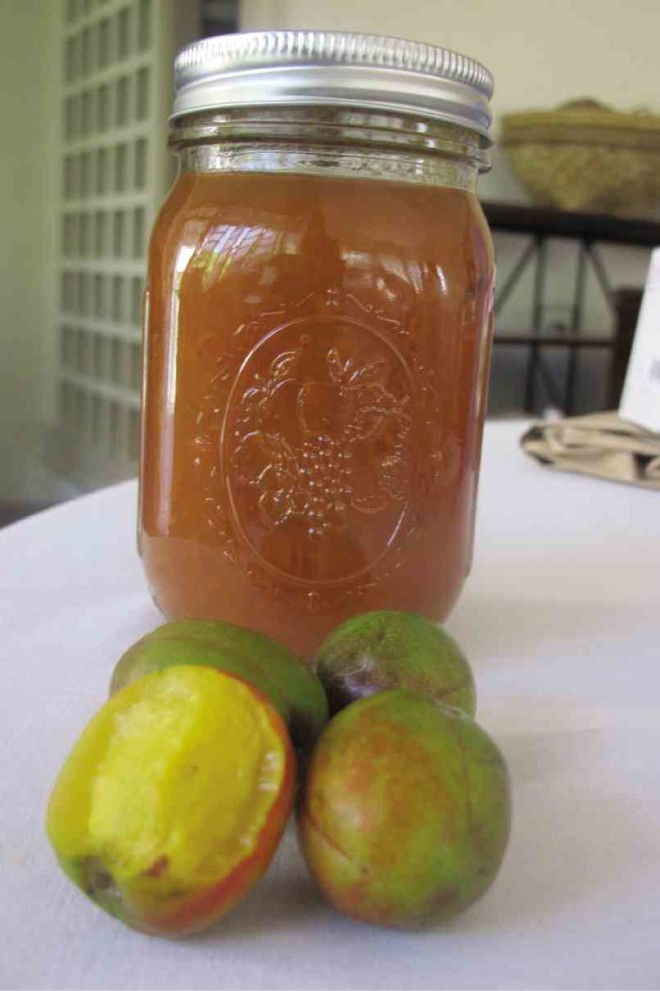
- Sineguelas Jam
Romy Dorotan and Amy Besa demonstrated ice-cream making involving two kinds of jam. First, the “jocote” jam, which is actually the sineguelas found in Mexico (the original fruit that came from Mexico during the Spanish era); second, local Philippine sineguelas, found in Siaton, Negros Oriental.
Sineguelas is known as Spanish plum. It has overtones of plum and mango. With the jocote (which Dorotan brought from New York City to Manila for the MFM demo), when cooked into a jam, the plum flavor dominates. With the local sineguelas, it was the mango flavor that came out.
That is why the couple had to figure out the ultimate cooking time for the jam to make sure that it still holds the sineguelas flavor.
For the ice cream, it is suggested to use very ripe sineguelas. Freeze them first and thaw properly.
1.5 kg frozen sineguelas (Yield: 750 g for jam and ice cream)
1¼ c white sugar (amount of sugar depends on the sweetness of the sineguelas and sweetness preference)
Juice of 6-10 pc calamansi (to taste)
Defrost the frozen sineguelas. (You may defrost it in a bowl filled with room-temperature water.)
Peel the skin and set aside.
Hand-press the seeds with the pulp in a colander to extract about 2 c (½ kg) pulp.
Chop the peel and set aside. Simmer the seeds in a little water for about 2 minutes. Measure the pulp and peel, sugar can be of equal measurement with the pulp and peel combined, more or less depending on your taste.
In a separate pot, combine the pulp, sugar and peel, then strain into it the simmered seeds and water, leaving the seeds out. Stir and boil over medium heat until thick.
To test if it is thick enough, dip and lift a spoon. If it produces a double drip, it is thick enough for jam. If it produces only one drip, cook a bit more. Be careful not to overcook the jam or it might lose the sineguelas flavor.
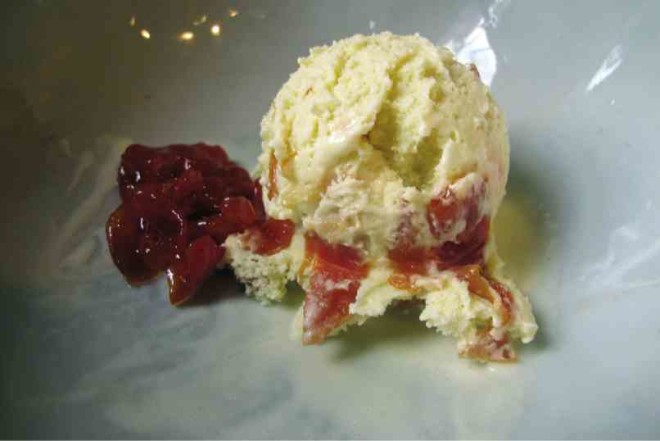
- Sineguelas Ice Cream
(Yield: ½ gallon)
3 c (705 g) heavy cream
1 ½ c (365 g) milk
10 pc (180 g) egg yolks
½ c (100 g) sugar
6 tbsp (75 g) sugar
500 g sineguelas Jam (450 g pureed for the custard and 50 g not pureed for folding into the ice cream. Alternatively, you can fold in all of the jam into the churned ice cream).
Beat the egg yolks in a mixer with the whisk attachment with ½c (100 g) sugar until fluffy. Scald milk and heavy cream with 6 tbsp (75 g) sugar.
With the mixer whisking the egg yolk mix (not so fast as it might cause splattering), slowly pour in a part of the milk-cream mixture into the egg yolk mix to temper the eggs.
Pour the tempered mix back into the pot to continue cooking the custard. Stir over low heat until thick. One way to test is if the temperature reaches 80ºC. Be careful not to overheat as it will either be too thick or the egg yolks will start to curdle.
Another way to test if the custard is cooked enough is to dip a wooden spoon in the custard. Lift it, then draw a line with your finger across the back of the wooden spoon. If the line remains distinct without the custard running over it for a few seconds, it is thick and cooked enough.
Strain the custard into a container in an ice bath. This will prevent the custard from cooking further (it might curdle the eggs) and it will remove any eggs that might have curdled. Let the mixture chill in the ice bath and stir it every once in a while.
Once the custard is cool, leave it in a chiller overnight before churning, but a well-chilled mix will do well in the ice cream machine.
Before churning the custard, mix in the 450 g of pureed sineguelas jam into the custard. Churn the custard according to ice cream machine’s instructions. It should be around the consistency of “soft-serve.” Fold in the rest of the sineguelas jam into the ice cream. Freeze the ice cream.
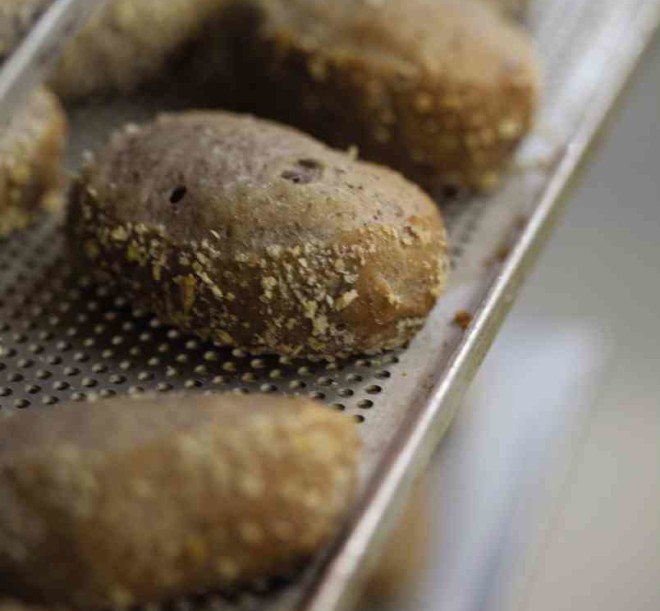
- Mango Flour Pan de Sal
For this unique kind of bread, Besa said they were just trying to integrate the mango flour in whatever recipes they had done before.
“Since the mango flour is gluten-free and is quite heavy, we had to use only a small amount and mixed it in with the flour,” she said. “We feel that even a small amount added to the flour makes the bread healthier adding nutrients and antioxidants to the bread.”
She added: “We welcome other bakers to experiment with more uses of it. Romy has come up with a crepe using mango flour mixed with rice flour and regular all-purpose flour to be used as lumpia wrapper and he says it is delicious, too.”
Serves 16 rolls
3 c (408 g) all-purpose flour, plus additional as needed
6 tbsp (40 g) mango flour
2 tsp (5.6 g) active dry yeast
3 tsp (15 g) salt
¼ c (50 g) sugar
½ stick (56 g) unsalted butter, at room temperature, plus additional for the bowl
½ c (45 g) fine dry bread crumbs
In the bowl of a standing electric mixer fitted with the paddle attachment, combine half of the bread flour and all of the mango flour. Add the yeast, salt and sugar. Pour in 1 c warm water (it should be between 90ºF and 100ºF) and mix to form a smooth batter. Blend in the butter.
Change the mixer attachment to the dough hook. With the hook in motion, add the remaining bread flour, ½ c at a time, until the dough has worked into a rough mass that easily pulls away from the sides of the bowl.
Transfer the dough to a large buttered bowl and cover with plastic wrap. Place in a warm, draft-free spot and let rise until doubled in bulk, about 1 hour.
Punch down to deflate, cover with plastic wrap, and let rise a second time until doubled in bulk, about 30 minutes.
Punch down once more and cut the dough in half. Working with one half at a time, form about 18 equal rolls (they should weigh 2 ounces each.) Roll the balls in bread crumbs to coat and place on baking sheet. Cover loosely with damp kitchen towel and let rise for 30 minutes.
During the final rise, preheat the oven to 400 ºF. Sprinkle the rolls with more bread crumbs and transfer to the oven. Bake until lightly browned and hard on the bottom for 20-25 minutes. Cool on wire racks.
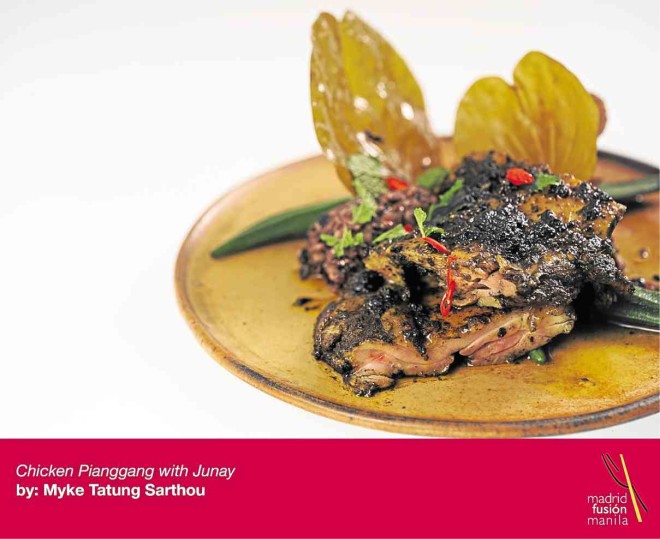
- Chicken ‘Pianggang’
Chef “Tatung” Sarthou, who recently launched his cookbook, “Philippine Cookery: From Heart to Platter,” focused on indigenous cooking, particularly Mindanao cuisine.
Sarthou sees Mindanao as the next culinary frontier of the Philippines and that there’s still so much to discover that gives Filipinos clues to their culinary past.
“The cuisine of indigenous Mindanao could be a clue to what our food was like, before the arrival of the Spaniards who altered not only our religious beliefs but our palates as well,” he said. “The food of Mindanao takes a different approach to many common ingredients, preparing it from a distinct taste preference.”
“Piyanggang manuk” is a special chicken recipe from Jolo. The chicken is first marinated in a paste of roasted coconuts, lemon grass, yellow ginger, chili, shallots and garlic.
The chicken is then simmered in coconut milk to tenderize and is cooked a second time by grilling to finish. This produces a delicious and smoky black chicken dish bursting with flavor.
The gravy, made from the chicken drippings, is served on the side as a dipping sauce.
Chicken Pianggang
Burning the coconut:
1 whole mature coconut
Scrape out thick white flesh of a mature coconut. Or ask the coconut vendor to do this for you. Break the flesh into large chunks, not small bits and pieces.
Roast coconut meat directly on burning charcoal or directly over the stove. Allow coconut meat to cook until charred and very fragrant. The milky component of the coconut breaks down and burns.
“Paitom” (Burnt Coconut Paste):
1 knob ginger
1 knob turmeric
6 cloves garlic
4 stalks lemon grass (white part, minced)
4 pc siling labuyo (more, if desired)
Salt and pepper to taste
Burnt coconut
Pound the charred pieces along with other ingredients in a mortar to make a paste. You can have it as a coarse or fine as you want. Or use a food processor to ground into a paste. Store in sterilized bottles and keep refrigerated up to one month.
1 k free-range chicken leg quarter fillet
Salt and pepper, to taste
½ c paitom (black curry paste), divided
2 c gata (coconut milk)
Salt and pepper to taste
Mint leaves and fried alibangbang leaves for garnish
Marinate chicken in salt and pepper and ¼ cup paitom for 1 to 3 hours. Arrange chicken pieces in a casserole and add coconut milk; braise for 20 minutes or until the oil renders. Allow to cook then.
Grill chicken over charcoal and transfer into a serving plate. If you want to make a gravy, add more coconut cream in a pot with the rendered paitom. Add chillies, if desired. Season with salt and pepper.
You may want to balance flavor with a little sugar and lemon juice. Pour the sauce over the chickens, or serve on the side. Garnish with mint leaves and fried alibangbang leaves.
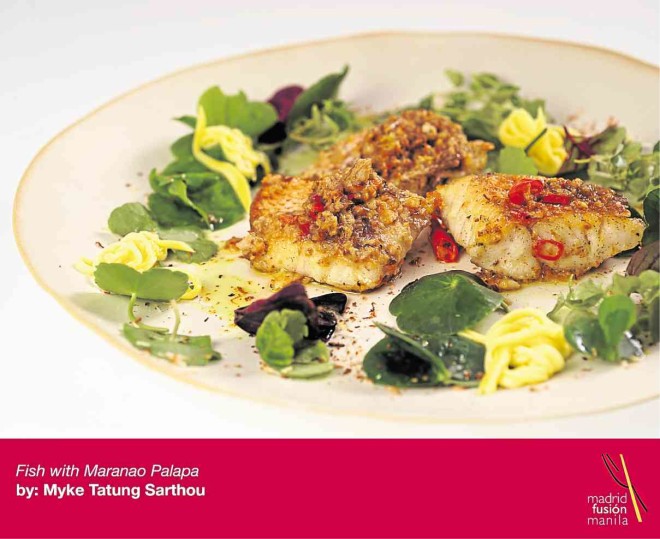
- Pan-seared Red Snapper Fillet with Maranao Palapa
“Palapa” is a Maranao spice paste used for seasoning food for cooking. It is also served tableside as a condiment. It uses the “sakurab” white scallion as the base for the recipe. The sakurab is an important spice for Maranao cooking.
Sarthou said the toasted grated coconuts is also an essential ingredient in making the palapa, which is very much like the “sambal” used in many traditional Tausug recipes.
500 g red snapper fillet
¼ c palapa (recipe below)
1 tbsp turmeric grated
1 c kakang-gata (coconut cream)
Salt and pepper to taste
Season red snapper fillets and sear until browned on all sides. Then set aside. With a little oil, saute grated yellow ginger and palapa, add coconut milk then return the fish fillets into the pan. Cook for a few minutes to cook fish through. Adjust seasoning if needed.
Arrange on a plate with local mesclun greens and garnish with marinated green mangoes.
Palapa:
1 c sakurab (thin white shallots)
12 siling labuyo (bird’s eye chillies)
2 knobs ginger, sliced
1 c coconut cream
1 c toasted grated coconut
Salt
Pound sakurab, chillies and ginger into a course paste. Set aside. Pour kakang-gata into a saucepan, bring to a simmer until fat renders and cream curdles. Keep stirring as not to burn the curds. Saute the spice paste in the coconut oil along with the curds until fragrant.
Add the toasted grated coconut and cook for a few minutes until you create a pasty consistency. Season with salt.
Marinated green mangoes:
½ c green mangoes, julienned
1 tbsp white sugar
Salt to taste

- Strawberry and Goat’s Milk Polvoron
Pastry chef Miko Aspiras was inspired by his newfound love for Filipino ingredients. “Friends helped me source ingredients from all over the country,” he said. “All I had to do is to pulverize, melt and combine ingredients. That, for me, makes a lot of sense.”
Baguio strawberry flour
Wheat flour
Palawan light honey
Bukidnon carabao’s butter
Samar goat’s milk powder
Roast the flour, cool it down, then mix in with strawberry flour, fold in goat’s milk powder. Toss in Palawan honey and melted butter.
Using your hands, press all ingredients together. Texture should resemble moist soil.
Press onto a mold. Let set inside the chiller. Remove from mold. Glaze then decorate.
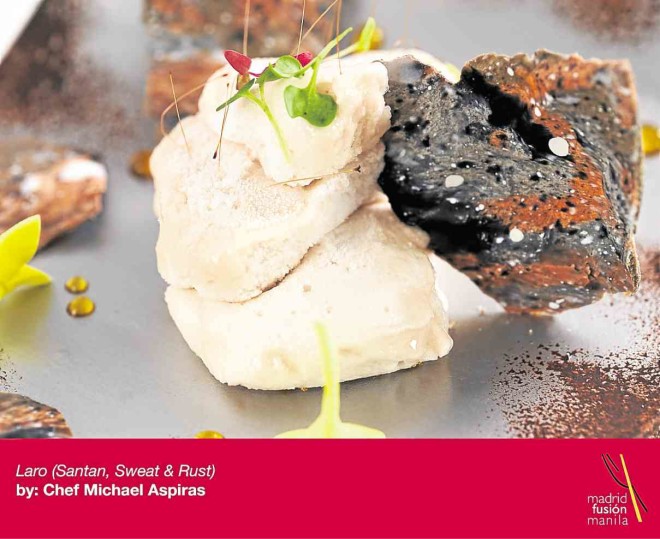
7 “Laro” (Santan Flower Frozen Meringue)
For this recipe, Aspiras looked back on his childhood.
“I used flavors that reminded how it was for me and for most of my growing up years in Manila,” he said. “Santan is the major component. Whenever I see, smell or taste this flower, it instantly brings me back to that time when I was carefree.”
Santan dew syrup
Ascorbic acid powder
Salt water
Manuka honey
Egg white powder/ovasil powder
Sugar
Water
Gelatin sheets
Bloom the gelatin sheets on iced water. Drain excess water. Set aside.
In a small bowl, stir together santan syrup, ascorbic acid, saltwater and Manuka honey. Whisk in the egg white powder until stiff. Make a syrup out of the water and sugar. Fold in gelatin. Fold the gelatin onto meringue.
Freeze until frozen and set. Serve.

